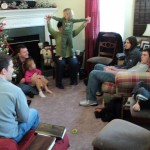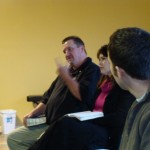Why I’m Not A House Church Proponent
I thought about the last word of the title of this post for some time. “Proponent” may not be exactly the right word here. Perhaps “Cheerleader” is a better word.
But, in this post’s title, I mean “Proponent” like this definition:
Proponent: a person who pleads for a cause or propounds an idea
Another possible description would be “enthusiast” in the following sense:
Enthusiast: an ardent and enthusiastic supporter of some person or activity
So, what am I saying? Am I saying that I am AGAINST house church? No, that is not what I’m saying at all.
I’m saying that I am not a cheerleader for house churches or the house church movement. Why not?
Well, there are at least two reasons.
First, in the New Testament, the church met in different locations. Yes, primarily we see the church meeting in homes in the New Testament. However, there are at least two locations where the church met that were not homes. The church met in some form in the temple in Jerusalem (Acts 2:46). Also, while in Ephesus, Paul and the other believers met daily in the “hall of Tyrannus” (Acts 19:9).
Second, simply moving a church meeting from a dedicated church building to a home does not necessarily change how the church meets. Unfortunately, I’ve read about many “house churches” that are simply traditional church structures and organizations transplanted into someone’s living room.
But, remember, the fact that I am not a house church proponent (cheerleader, enthusiast) does not mean that I am against house churches. I have met with the church in my house and in any number of other houses. I enjoy meeting with other believers in houses.
But, my goal – and the purpose of this blog – is not to get as many people as possible to meet in houses. Instead, my goal is to get believers to recognize their responsibility to build up (edify) one another (mutually) whenever and wherever they meet together.
Now, I do believe that some locations are better for church meetings than others. I believe that some setups or seating arrangements are better than others. But, that does not mean that believers cannot edify one another when meeting in a less than perfect location (as if there is a perfect location) or sitting in less than perfect arrangements (as if there is a perfect arrangement).
My hope is that each church will consider their current method of meeting together and attempt to change that method however necessary to help one another begin to encourage, teach, admonish, serve, and build up others. If this happens among a group meeting in a house, then great! If it happens among a group meeting in a school, awesome! If it happens in a church meeting in a big building with a steeple, fantastic!
So, no, I am not a house church proponent. However, I am a church proponent: I plead for the cause of allowing Jesus Christ to build up his church through all of those meeting together, not just through a few. I am a church enthusiast: I am an ardent supporter of the church gathering together for the purpose of the whole church helping one another grow in maturity in Jesus Christ.
Dangerous Sunday – The Man
In the previous posts in this series, I suggested that it is dangerous to the spiritual maturity of believers to place an extraordinary emphasis on Sunday as “The Day” or a specific location as “The Place” or a specific set of activities as “The Program” for Christians to meet together as the church.
In this final post of the series, I want to focus on another “danger” of the modern, traditional Sunday: a focus on a specific person or group of people who must “lead” the church meeting. Usually, this person is the senior pastor, sometimes combined with other “staff” such as “minister of music” (minister or worship) or perhaps another “associate pastor.”
And, what happens when that person (the senior pastor) can’t be there – rare though that must be? He (or she) hand picks a replacement.
At the time when the church comes together, teaching, edification, discipleship, etc. is placed in the hands of one person. The church loses its mutuality. The focus turns to that man, and the church learns that they are not the church if “the man” is not up front leading them – or at least giving his approval of the person to take his place.
The modern, traditional focus on a particular person is extremely dangerous to the spiritual health of the church, all in the name of helping the church. The fact that this practice is considered both necessary and healthy makes it even more dangerous.
Instead of God being allowed and expected to work through the church to help the church grow (Eph 4:16), God is now expected only to work through the professional, pastoral staff and especially the senior pastor. Once again (as with the day, the place, and the program), the focus is taken off of Christ and placed on an individual – yes, even when that individual thinks that he (or she) is placing the focus on Christ.
The church, instead, should be working together to build one another up. As the Spirit works through all his children, the church is strengthened and encouraged (in Paul’s words) “until we all attain to the unity of the faith and of the knowledge of the Son of God, to mature manhood, to the measure of the stature of the fullness of Christ.” (Ephesians 4:14)
This warning is not against leaders among the church – as long as we understand that Jesus defined leadership as service – no, not “servant leadership” but service. A focus on “the man” up front turns Jesus’ teaching about service upside down. In fact, it’s changing Jesus’ counter-cultural teaching about leadership/service back into a worldly view of leadership.
God dwells in each of his children and can (if allowed) work through each of his children to build up his church. The modern, traditional focus on “the man” hinders that growth.
Dangerous Sunday – The Program
In the previous posts in this series, I suggested that it is dangerous to the spiritual maturity of believers to place an extraordinary emphasis on Sunday as “The Day” or a specific location as “The Place” for Christians to meet together as the church.
Besides teaching people that they are only the church on a particular day and at a particular place, the practices of modern, traditional churches also dangerously teach people that the church is only meeting when they follow a particular program. Sometimes this is called liturgy. Sometimes it’s a specific set of activities or events that must happen.
Can you imagine what would happen on Sundays among most churches if there were no songs? What if no one preached a sermon or delivered a homily? What if certain creeds or prayers were not recited in unison?
And, yet, none of these things are necessary for the church to meet. However, because most churches practice these things “religiously,” people are taught that they are necessary and if they don’t happen (sometimes in a certain order) then it is not church.
In this case, it is not the day or the place that is defining the church, but a certain set of activities. Interestingly, these activities typically have little to do with the people involved. Anyone could sing the songs or recite the creeds/prayers, and it would still be considered church. The people themselves are replaceable. The people no longer define the church; certain activities – the program – defines the church.
Once again, this gets to the question of identity. The people are the church because Christ dwells in them, and they are gathered together. But, when we show people week after week that certain things must happen when the church meets, then we confuse their understanding of what it means to be the church.
When this happens, Christ is no longer the center and power of the church; that particular program is the center and definition of the church. This is dangerous; yes, even when the program is Christ-centered. A program – even a Christ-centered program or liturgy – is not Christ himself.
I know what some are thinking: “Just because we always do certain things and say certain things when the church meets, we still teach that the people are the church.” Sure, but our actions speak much louder than our words. We’re teaching people that they are only the church when they do certain thing when we practice those things over and over and over and over without exception.
The activities that we take part in and the things that we say do not make us the church. Gathering together as God’s children makes us the church – whatever we do and whatever we say.
Dangerous Sunday – The Place
In a previous post in this series, I suggested that it is dangerous to the spiritual maturity of believers to place an extraordinary emphasis on Sunday as “The Day” for Christians to meet together as the church.
But there is another more dangerous emphasis that is often found among the modern, traditional church today: the place – typically a building designated for church meetings (i.e., worship services). (Of course, those who ‘house church’ could look at their particular house in the same dangerous manner.)
When I was growing up, the church building was like the temple in many ways. Oh, we SAID that our bodies were the temple of God, but we ACTED as if the church building was. There were even different levels of holiness attached to the church building.
There were things you could do/say elsewhere that you did not do/say while on church grounds. There were things you could do/say on church grounds that you did not do/say while in the church building. There were things you could do/say in the church building that you did not do/say while in “the sanctuary.” There were things you could do/say in “the sanctuary” that you did not do/say while on the platform. There were things you could do/say on the platform that you did not do/say while standing behind the pulpit.
These practices – and many others – demonstrated that we considered that specific building to be a special building. People could get together in their homes (fellowships or Bible study) or in parks or wherever, but it was only “church” when we gathered in that particular building.
Again, this teaches that our identity in Christ and as the church when we are together depends upon being in a particular place (and, usually, on a particular day at a particular time).
In fact, I’ve talked to many Christians who grew up in that kind of environment who believe that they can treat people (the same people) differently when they are not in “the church building.” And, even if those believers will not actually state that as their belief, their lives demonstrate that it is.
When we emphasize a place as “the place” for the church to meet, then we are teaching people that their identity as the church does not depend upon their relationship with God through Christ and their mutual relationships with one another, but instead, it depends upon being in a particular place.
It is in this particular place that people dress up (their clothes and their actions) to be the church, while living differently anyplace else. What? You say that you teach just the opposite? Perhaps with your words… but what do your actions and practices teach? Believe me, people learn more from our actions than from our words.
Instead of hampering the spiritual growth of our brothers and sisters, let’s remind them that they are “church” whenever and wherever they are together with their brothers and sisters in Christ.
Simple, Relational, Powerful
Often, people ask me what our church meetings are like. I’ve described them a few times here. But, given the hybrid structure of our church, our meetings are often more programmatic and structured and complex. Some people want to know what a church meeting would look like if it was simply a group of believers meeting together in a home.
Last Sunday, our family gathered together with two other families in one of their homes. We read and discussed Scripture together. Asked questions. Listened to one another. Sang a song – a carol requested by one of the children. Prayed. Shared a meal – beef stew, red beans and rice, and some brownies. And continued talking about what God was doing in our lives and where we see him leading us. Primarily, we enjoyed one another’s company in Christ and helped one another grow in maturity in Christ.
We’ve known these two families for a few months. (I’ve known one of the husbands longer.) We first met them when they desired to begin meeting in their neighborhood for the purpose of building the kingdom of God there. Their church was not interested in helping them, so we said that we would. They met with us for a while, then began meeting on their own.
It was encouraging to hear these two families talk about their efforts in showing God’s love to their neighbors and co-workers and to share what God had been doing in our lives. Already, they’ve served people in many different ways. We talked about how we can continue serving God together by reaching out to and serving hurting people in our community.
It truly was a simple, relational, powerful time of getting together as the church with our brothers and sisters in Christ.
Dangerous Sunday – The Day
Typically, I try to write about the church from a positive perspective. Instead of writing about what’s wrong with the modern church, I usually write describing the positive characteristics and activities of the church as we see it in Scripture. Now, many of my readers automatically recognized the negative side of what I write. However, I still try to write from the positive perspective. I write about what the church should be, not what it shouldn’t be.
In this series, though, I want to write about modern, traditional church. Now, right away, there are problems with the design of this series. You see, no church will exactly look like or do the things that I write about. But, I hope that each reader will consider their own church and their own practices in order to determine if some of these aspects of the “general” modern, traditional church may apply. I think that we can all find “dangerous” practices of each of our churches.
What do I mean by “dangerous”? Primarily, I mean those practices that teach things that are contrary to our reality and identity in Christ. I’m talking about practices that are certainly used by God, but are not necessarily the best that God has provided for his children.
For this first installment, think about the day – Sunday. In many cases, “church” is defined by the day. The same group of people can do the same things on Monday, but it’s not considered “church” because it didn’t happen on Sunday.
While we do have an instance (yes, just one) in Scripture of the church meeting on Sunday (Acts 20:7), we have more examples of the church gathering together every day (Acts 2:46, Acts 9, and perhaps Hebrews 3:13). The church is not defined by the day on which it meets.
But, when we focus on a particular day, we teach people something “dangerous.” We teach them that they are the church because of the day, not because of their identity in Christ. (Of course, this is usually combined with – and can’t be separated from – a particular location and doing specific things, but we’ll look at those later.)
Obviously, there’s no problem with believers meeting together on Sunday. We see church in Troas meeting on Sunday while Paul is with them, and the churches in Jerusalem and Ephesus met together on Sunday (since they met together daily).
However, there is a difference between meeting together on Sunday and somehow holding Sunday as a special day to meet together. Instead, we should encourage believers to meet together whenever they can – on Sunday and on any other day.
It can be dangerous to hold Sunday as a special day (or even the only day) for the church to meet together. By doing so, we are teaching people that their identity as the church is tied to a day instead of to their relationship with Christ and their mutual relationships with one another.
Taking the Next Step
A couple of weeks ago, I wrote a post called “The Next Step.” In that post, I talked about how important it is for us to talk about service and to encourage one another to serve others. But, I wondered out loud what it would look like – and what it would mean for the church – if we actually took the next step and left to serve others directly from our meeting together.
This is what I called “the next step” – the step away from concept and toward action. The step away from talking about discipleship and service toward actually discipling and serving others. I wrote:
Imagine, we’re sitting together as the church (either around tables or in a circle), and someone expresses a struggle with sharing the gospel with a neighbor. We encourage the person and pray for him or her. Then – the next step – someone offers to go with that brother or sister (perhaps at that very moment) to share the gospel with the neighbor. Or, perhaps someone else offers to take the struggling brother or sister along on a trip to the food pantry when the gospel is often shared.
There are so many possibilities, but it means taking the next step – the step away from concept and toward action.
Well, last Sunday, we started taking that step.
During the month of November, out teaching/discussions on Sundays with the church have focused on the great commandment and the great commission. We’ve primarily exhorted and challenged one another to think about how we can take the community that we share in Christ out to others. We’ve talked about taking our “shared life in Christ” to those who are also in Christ but do not share community with others, and we’ve talked about taking our community to those who are not believers.
Last Sunday, Rodney was planning to lead our teaching/discussion time. He sent an email before Sunday letting everyone know what we would be talking about, so that we could all come prepared. Here is part of his email:
How can we, practically and specifically, help each other to abide in Chirst (and thereby fuel our love for God and our love and service to others in the name of Christ)? To help us be practical and specific… what ways have others helped you grow in your faith, trust, and obedience to Christ? And in what other ways could others help you? (emphasis in original email)
So, when we got together, we did talk about practical and specific way that we could help others and ways that we could be helped. Several people shared opportunities that they’d had in the last couple of weeks to demonstrate the love of God, or times when they’d witnessed and been encouraged by others as they loved and served in the name of Jesus.
Slowly, a few people began making suggestions about how we could specifically serve others. One sister told about an opportunity to spend time in a local hospital. Another sister shared about a family who was having financial problems. A brother shared about his neighbor. A couple of sisters talked about the elderly people they see during the week. The church could serve all of these people in some ways.
Then, a young lady – a teenager actually – spoke up. She had gone with us when we had provided “More Meals” to some of the needy people in our area. She remembered that one of the elderly ladies that we had visited needed her yard raked.
And, this is where we took “the next step.” Margaret, my wife, suggested that whoever was available that afternoon could go to this lady’s house and rake her leaves. Everyone thought this was a great idea! So, we ate lunch together, then several of us (about 14) went to the lady’s and raked the leaves in her yard.
The lady was so surprised and grateful! Margaret and another friend (and our daughters) will continue to see this lady and her husband at least once per week. They will continue to be able to impact their lives with the love of Christ. And, now, because we took the next step, the whole community is involved in this couple’s life!
I’m praying that we continue to take the next step.
How many should speak?
There’s a good discussion over at Eric’s blog “A Pilgrim’s Progress” and his post “Six Sacred Cows.” While most add “sacred cows” to Eric’s list, one commenter disagrees with Eric’s statement concerning “the sermon.”
Here is Eric’s statement:
5. The Sermon
Each week as churches across this country gather, one man will stand up in front of the assembly and “bring a message from God.” Wow. That sounds impressive. The problem is that, as we have seen before, this is not a N.T. church practice. Simply put, one-direction preaching didn’t happen in early church gatherings.
This is a massive sacred cow. If you challenge it, be ready for a not so friendly response.
When the early church gathered, we see many people sharing teachings from scripture. This may have been pastors, but maybe not. Many people taught; nobody preached – especially not a sermon like we see today.
Here is my comment and my addition to the discussion:
If we only look at 1 Corinthians 14:26-40, we see at least 7 people speaking: three speaking in tongues, at least one (possibly more) interpreting the tongues, and at least three prophesying. However, Paul also includes that others should weigh the prophecy… so that would be more than 7 people speaking. As you’ve mentioned, Paul does not tell us how many should bring psalms or teaching. Let’s assume he would use the same principles: that would mean 3 people bringing songs/psalms and 3 people teaching. So far, we’re up to at least 13 people speaking when the church meets, just from 1 Corinthians 14:26-40. That’s certainly more than I’ve seen at every church that I’ve met with (except one).
But, there’s another part of this discussion. When we say someone teaches, we usually think of lecture style teaching, which means that one person speaks and everyone else is quiet. Is that what Paul meant? Perhaps. But, perhaps not. We have several examples of Paul speaking to unbelievers. But, we don’t have many example of how Paul taught the church. There are two striking examples however.
1) In Acts 19:9, we see Paul and the disciples of Jesus leaving the synagogue to meet in the Hall of Tyrannus (not a home, by the way). It says that Paul continued “reasoning” with them (according to the ESV). This same verb is used to describe Paul’s speech among the Jews in the synagogue in Acts 19:8. What does this verb mean? Well, it has a wide range of meaning, but it is the source of our verb “dialogue”. It could mean anything from a dialogue between two people to a discussion between many, to an all out argument. In essence, the verb indicates that more than one person was taking part in the speaking.
2) Using the same verb (dialegomai, if you’re interested) Luke describes how Paul spoke to the church in Troas in both Acts 20:7 and Acts 20:9 (translated “talked” in ESV).
In both of these examples of Paul speaking to the church, a verb is used to indicate dialogue or discussion. How many people were speaking during this time? It’s hard to say.
So, just looking at these three passages, it seems clear that several people spoke (in order and without chaos) when the church met in the NT.
What do you think? When the early church met, did they meet to listen to one person speak, or did they meet to speak to and with one another – that is, many people speaking (decently and in order, of course)?
What’s on the menu?
Curry chicken… vegetable soup… Mexican lasagna… homemade wheat rolls… spaghetti and meatballs… pineapple and lime chicken tacos… shredded barbecue chicken… chili… spring mix salad… cheesecake… mmmmmmm…
So, this is a sampling of some of the food that we shared with one another yesterday when we met together as the church.
But, there was other food as well… good food… spiritual food… that was even more tasty and nourishing.
(Unfortunately, I did not take my camera with me yesterday, so I do not have a picture of that scrumptious spread.)
The Next Step
As some of my readers know (and some may not know), when our church meets together, the teaching is a little different than the teaching (preaching?) when most churches meet. What do I mean? Well, typically, our teaching is in the form of a discussion.
Generally, we have an agreed up subject or passage of Scripture. Someone agrees to teach that subject or passage. What that means is that that person facilitates a discussion concerning the subject or passage. The amount of lecture combined with discussion/dialog depends on who is teaching / facilitating our teaching time.
Since more than one person is speaking, the teaching can get very specific. Someone may ask a specific question that affects what the person is facing in life. Another person may make a completely different comment, but just as specific and just as personal to that person or to someone else.
The last time we met as a church, we met around tables. When we do this, along with the teaching I described above, the person leading our teaching also gives us a question or topic to discuss around each table (with 6-10 people at each table). In this way, even more people take part in the teaching, and even more specific and personal questions or applications or problems or comments are considered.
This type of teaching is much more direct and more personal and (I think) more discipling than any other that I’ve ever experienced. But, there may still be something missing. Let me try to explain.
Margaret, my wife, and I were talking about the teaching and our time together. Later, we also talked with another couple who are our close friends. We all agreed that something is missing, and that’s the next step. The next step would be for the teaching to move beyond words and concepts into action.
Let me give you an example. Suppose, for instance, that we’re talking about reaching out to our neighbors, coworkers, family, etc. with the gospel. As we talk about this subject, several people may offer specific examples of opportunities that they’ve had to share the gospel with others. Others, then, would probably share that they know that they need to share the gospel (and they may even have someone specific in mind), but they struggle with doing that. We would probably encourage that person, and even pray for him or her right then.
But, what about the next step? What needs to happen next? Well, someone needs to come alongside that person and help him or her to share the gospel with the other person that God has brought to mind. And, that could happen right away.
Imagine, we’re sitting together as the church (either around tables or in a circle), and someone expresses a struggle with sharing the gospel with a neighbor. We encourage the person and pray for him or her. Then – the next step – someone offers to go with that brother or sister (perhaps at that very moment) to share the gospel with the neighbor. Or, perhaps someone else offers to take the struggling brother or sister along on a trip to the food pantry when the gospel is often shared.
There are so many possibilities, but it means taking the next step – the step away from concept and toward action.
I think this is an important step for us (and any church and all believers) to take. Why? Because discipleship (becoming more mature in Jesus Christ) is not only about concepts. Instead, it’s also about obediently following Jesus Christ throughout our lives.
Have you ever been part of a church meeting when people took the next step, and actually acted to help a brother or sister right away (it doesn’t have to be with evangelism, it could be with anything)? What do you think?







